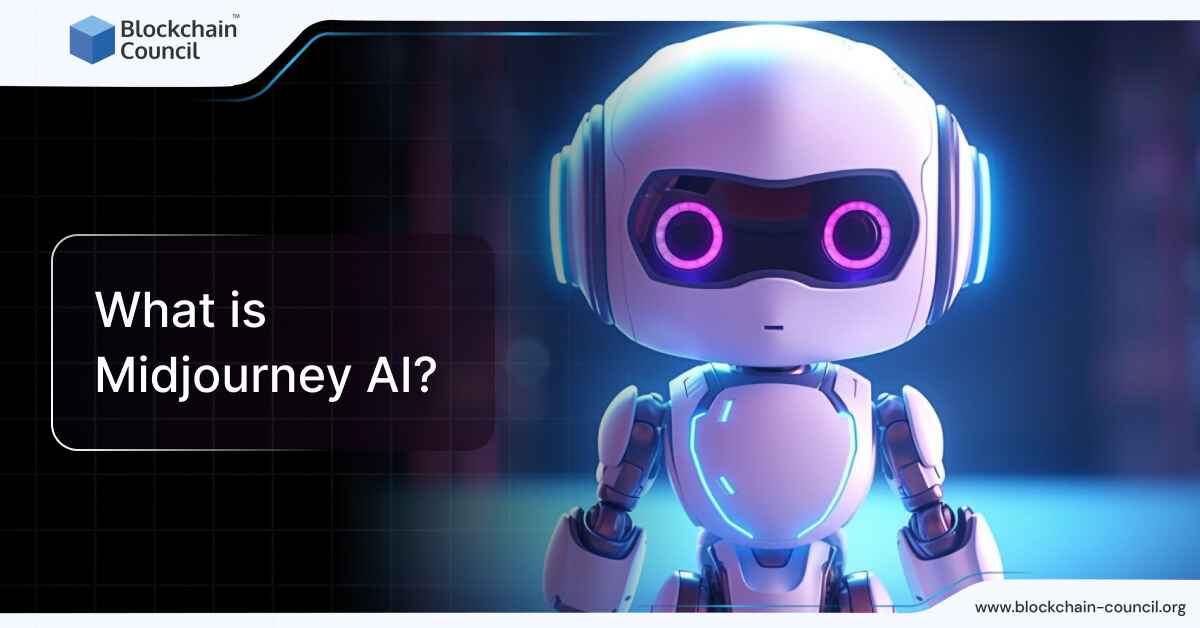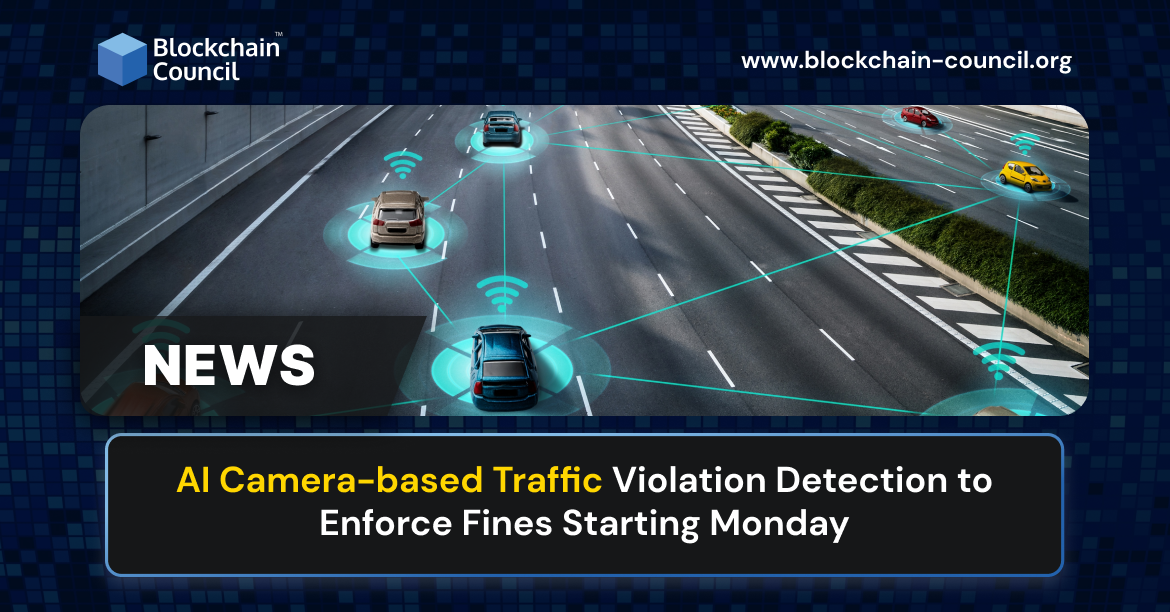
- Blockchain Council
- September 02, 2024
What is Midjourney AI? Defined
Midjourney AI is an advanced generative artificial intelligence tool that specializes in creating images from textual descriptions or prompts. It operates as a service provided by an independent research lab, Midjourney Inc., which focuses on exploring new mediums of thought and the expansive imaginative powers of humanity. Unlike other image generation services that might offer open-source insights or free trials, Midjourney distinguishes itself by being a closed-source, self-funded project. This makes it a bit of a mystery regarding the specific inner workings of its technology. However, it’s known that the service leverages cutting-edge machine learning techniques, including diffusion models and large language models, to produce high-quality, realistic images based on the prompts it receives.
Also Read: What is Janitor AI?
How does it Work?
Midjourney operates through a Discord bot, making it highly accessible to users without the need for specialized software or hardware. This approach simplifies the image generation process: users simply type a command along with their prompt, and Midjourney’s AI springs into action, crafting a set of images that reflect the user’s input.
To create images, users provide Midjourney with text prompts, which can range from vague to highly detailed descriptions. The more specific the prompt, especially with details on styles, colors, and composition, the better Midjourney performs. It’s recommended to use shorter prompts, ideally under 25 words, to achieve the best results. The AI then follows these textual cues as closely as possible to generate images.
Core Technology Behind Midjourney
Midjourney AI utilizes advanced machine learning techniques to transform text prompts into detailed images. Here’s the core technologies behind this innovative tool:
| Technology | Description |
| Machine Learning & AI | Utilizes vast image datasets to learn and recognize shapes, colors, textures, creating images from prompts. |
| Natural Language Processing (NLP) | NLP analyzes the text prompts, breaking down the language to understand the semantics. This process allows Midjourney to interpret the meaning behind the words typed by users, effectively translating descriptions into a format that the AI can work with. |
| Diffusion Models | These models are crucial for image generation, starting with a field of visual noise and gradually refining this into a coherent image. By reversing the noise added to training datasets, diffusion models can create entirely new images based on the input prompts. |
| Reinforcement Learning from Human Feedback (RLHF) | Employs human rankings to train the AI, aligning outputs with human preferences and values. |
| Generative Adversarial Networks (GANs) | Generative AI, including GANs, is a key part of its technology. GANs involve two neural networks working against each other to improve the realism of generated images. |
Also Read: What are Agents in Artificial Intelligence (AI)?
Key Features of Midjourney AI
Midjourney AI distinguishes itself through several unique features and benefits:
- Ease of Access: Unlike many competitors that require specialized software, Midjourney operates through the Discord app, making it accessible to a wider audience without the need for additional hardware or software.
- Version Evolution: Starting with version 1 in February 2022, Midjourney has introduced multiple updates, each enhancing the AI’s ability to produce more nuanced and stylistically varied images.
- High-Quality Realistic Images: It is renowned for its ability to generate realistic, well-structured, and detailed images, positioning it as a strong competitor against other AI tools like Stable Diffusion and DALL-E.
- Customization and Control: Midjourney provides users with a range of commands and parameters for fine-tuning generated images, offering better control over the final output. This level of customization stands out among image-generating tools.
- Community and Continuous Development: The Midjourney team is committed to continuous improvement, ensuring the tool keeps pace with the rapidly evolving AI space. Additionally, the Midjourney Discord server fosters an active community where users can share images, ask questions, and receive support.
The Role of Prompts in Midjourney AI
Prompts serve as the cornerstone of Midjourney AI’s image generation process. Users provide descriptive text, which Midjourney interprets to create images. The specificity and creativity of these prompts significantly influence the quality and relevance of the generated images. To enhance this process, users can employ advanced prompt techniques, incorporating multiple text phrases or even image URLs to guide the AI more precisely towards the desired outcome. This advanced prompting allows for greater control over the style, composition, and content of the generated images, making it an essential skill for anyone looking to leverage Midjourney AI to its fullest potential.
For those interested in mastering the art of effective prompt creation, the Certified Prompt Engineer™ certification by the Blockchain Council offers a structured learning path. This certification is designed to equip individuals with the knowledge and skills needed to craft prompts that yield high-quality, relevant images in Midjourney AI and other generative AI platforms. It covers the principles of prompt engineering, advanced techniques for prompt optimization, and strategies for enhancing the creativity and effectiveness of AI-generated content. By obtaining this certification, users can significantly improve their ability to produce compelling and aesthetically pleasing images with Midjourney AI, opening up new possibilities for creative expression and professional application.
Also Read: What is Gemini AI?
Applications of Midjourney AI
Midjourney AI has been instrumental in transforming various industries with its innovative image generation capabilities. Below we can see its key applications across different fields:
| Application | Description |
| Artistic Creation | Artists use Midjourney for rapid prototyping of concepts, exploring new artistic styles, and generating unique artworks. |
| Advertising | The advertising industry leverages Midjourney to brainstorm ideas, create original content, and design custom ads tailored to individual preferences. |
| Architectural Design | Architects utilize Midjourney for generating mood boards, exploring design alternatives, and visualizing architectural concepts in the early stages of projects. |
| Education and Research | It serves as a tool for educational purposes and research, facilitating learning by visualizing complex subjects. |
| Entertainment | In the entertainment industry, it’s used to create concept art, character designs, and backgrounds for games and movies. |
These applications showcase the versatility and potential of Midjourney AI in enhancing creativity, efficiency, and innovation across a wide range of sectors.
Also Read: What Are AI Content Detectors?
History of Midjourney AI
- Launch and Initial Versions: Midjourney AI began its journey with its first version (V1) in February 2022, quickly followed by subsequent updates that introduced improved versions every few months. Notably, V2 was released in April 2022, with V3 making its debut in July 2022.
- Alpha Releases and Enhancements: The alpha iteration of V4 was introduced to users in November 2022, followed by the alpha iteration of V5 in March 2023. These versions brought significant enhancements, including more opinionated stylizations in V5.1 (May 2023) and increasingly better image quality up to V5.2 (June 2023).
- Special Models and Collaborations: Unique models like the Niji model, a collaboration with Spellbrush aimed at anime and illustrative styles, were introduced starting in December 2022 and saw updates into 2024.
- Recent Developments: The latest, V6, was launched in December 2023 after being trained from scratch over nine months, incorporating improved text rendition and more literal interpretations of prompts.
Also Read: How Does Character AI Work?
Conclusion
As we conclude our exploration of Midjourney AI, it’s clear that this technology is not just a tool but a catalyst for a new era of creativity and innovation. By bridging the gap between human imagination and digital execution, Midjourney AI empowers individuals and organizations to push the boundaries of what’s possible in art, design, and beyond. The journey of Midjourney AI, from its inception to its current state, underscores the profound impact of artificial intelligence on creative processes, offering a glimpse into a future where AI and human creativity work hand in hand to create wonders yet unseen.
Frequently Asked Questions
What is Midjourney AI?
- Midjourney AI is an advanced generative artificial intelligence tool developed by Midjourney Inc.
- It specializes in creating visual imagery from textual descriptions or prompts.
- The technology operates as a service accessible through a Discord bot.
- Midjourney AI is renowned for its ability to produce high-quality, realistic images based on user input.
How does Midjourney AI work?
- Users provide textual prompts to Midjourney AI through the Discord bot.
- The AI interprets these prompts and utilizes advanced machine learning techniques such as NLP and diffusion models to generate images.
- Shorter and more detailed prompts tend to yield better results.
- Midjourney AI continuously evolves through updates, incorporating user feedback and advancements in AI technology.
What are the key features of Midjourney AI?
- Accessibility: Operates through Discord, eliminating the need for specialized software.
- Version Evolution: Regular updates enhance the AI’s capabilities and image quality.
- High-Quality Images: Known for producing realistic and detailed visuals.
- Customization: Users have control over parameters to fine-tune generated images.
What are the applications of Midjourney AI?
- Artistic Creation: Used for rapid prototyping, exploring new styles, and generating unique artworks.
- Advertising: Helps in brainstorming ideas and designing custom ads.
- Architectural Design: Facilitates the visualization of concepts and alternatives.
- Education and Research: Supports learning by visualizing complex subjects and aids in research projects.
- Entertainment: Utilized for creating concept art, character designs, and backgrounds in games and movies.





































































 Guides
Guides News
News Blockchain
Blockchain Cryptocurrency
& Digital Assets
Cryptocurrency
& Digital Assets Web3
Web3 Metaverse & NFTs
Metaverse & NFTs
